Ford V3000 S (1939)
 Germany (1939-48) - Standard Medium Truck - 25,000 1939-45 built
Germany (1939-48) - Standard Medium Truck - 25,000 1939-45 built
The Ford V 3000 and Ford B 3000 were series of 3-ton class trucks built by the German Ford-Werke AG at Cologne-Niehl during the Second World War. At the start of the war, the B3000 and V3000 were part of the standardized german military trucks, with the Magirus S 3000, Mercedes L 4500 S and Opel 3Tons (the legendary Blitz). The name derived from the payload's total weight, in Kgs. It derived from the Ford G 987 T (4-cylinder) or 3t model 1939 by its new streamlined bonnet and from the US model by its unitary windshield. About 25,000 were manufactured until 1945 and the serie went on postwar until closed in 1948.
Design development 1931-38
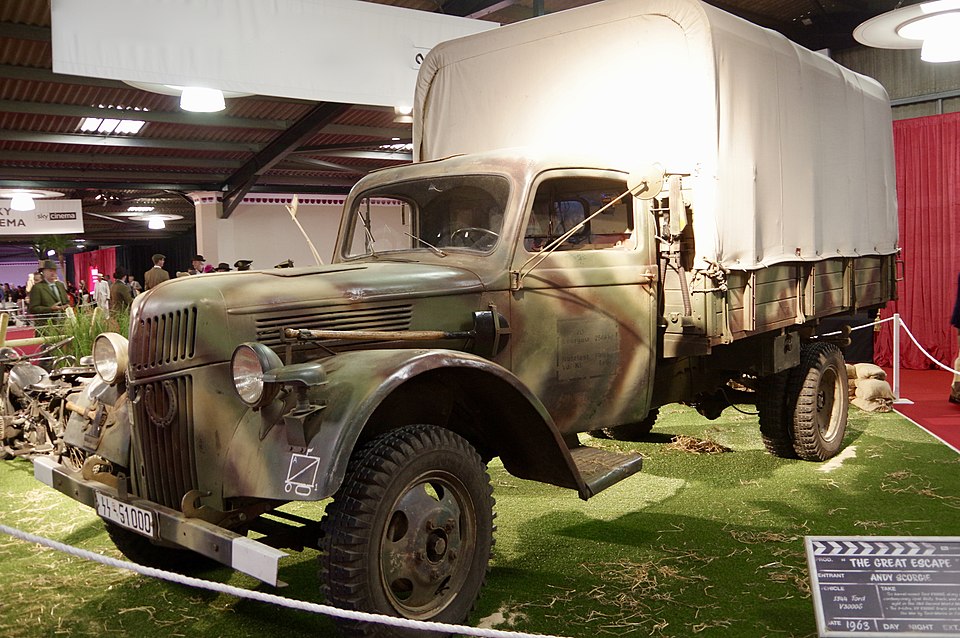 V3000S used in the "great escape"
V3000S used in the "great escape"
About Ford Germany
From May 4, 1931, Ford-Werke Aktiengesellschaft started manufacturing commercial vehicles in Köln (Cologne). From a V8 engine developed in the USA in 1931, a team led by engineer Richard Bussien succeeded in creating a new German 6-cylinder engine able to deliver a continuous output of 75 hp (55 kW), perfect for the newly made Autobahn. Further development led in 1936 to the V8-51, a 3-ton truck with a 3.6 l displacement and rated for 90 hp (66 kW).
The same year, Ford developed the engine exchange system, a process enabling quicker and easier swap from a defective engine with a new one. This reduced downtime, but required large hoods to absorb any change. Due to fuel shortages in Germany, the first vehicles with Imbert wood carburettors were produced as early as 1936. From the fall of 1937, US production vehicles still bore the Ford logo on the front whereas the vehicles from Cologne were forbidden by the brand to display it and instead started to use a symbolic representation of Cologne Cathedral instead. The Wehrmacht started to purchase vehicles from Ford Cologne, starting in the summer of 1937.
Attempt to reduce the plethoric catalog used by the Wehrmacht led to a stabdardization effort imposed on the industry, the "Schell Plan", developed in 1939. This standardization in truck models built for the the German Reich was applied from January 1, 1940, in order notably to sparingly use war-critical resources, and reaching more efficience through standardization and simplification, notably to streamlined supply and repair, especially for troops at the front, notably for the supply of spare parts.
The result was the 3-ton standard truck, to which Ford Germany had to align its own range. Even after Germany declared war on the USA in December 1941, Ford Germany continued production unchanged. However ford at home was widely criticized for this and eventually stopped supplying anything from 1942. The Ford 77-81 ("Barrel-Nose Truck") model, just launched in Cologne was discontinued as no parts came anymore from the USA.
Development
The starting point for development were the 1939 models G987T (50 hp/3.2 l) and G917T (90 hp/3.6 l), and the 1941 model G997T (95 hp/3.9 l) already in service with the Wehrmacht. Ford worked with a descriptive model code imposed from the US, where "G" stands for "Germany", the first number for the year of production, second number for the engine type, third number for the wheelbase, and "T" for Truck. All the above were integrated in the 3000 series.
The Ford V 3000 S, B 3000 S, and V 3000 A trucks were built from 1941, based on the 1940 "facelift" model from Ford's parent company in Detroit as the Ford Type T 098/099, sporting the V8 gasoline engine rated for 239 cubic inches or 3.9 liters and an output or 95 hp, introduced at the same time in the USA. In the USA and Canada, Ford also built a Ford Six and Eight series in 1941 onwards, available as a panel van version, with a lower payload capacity.
Design
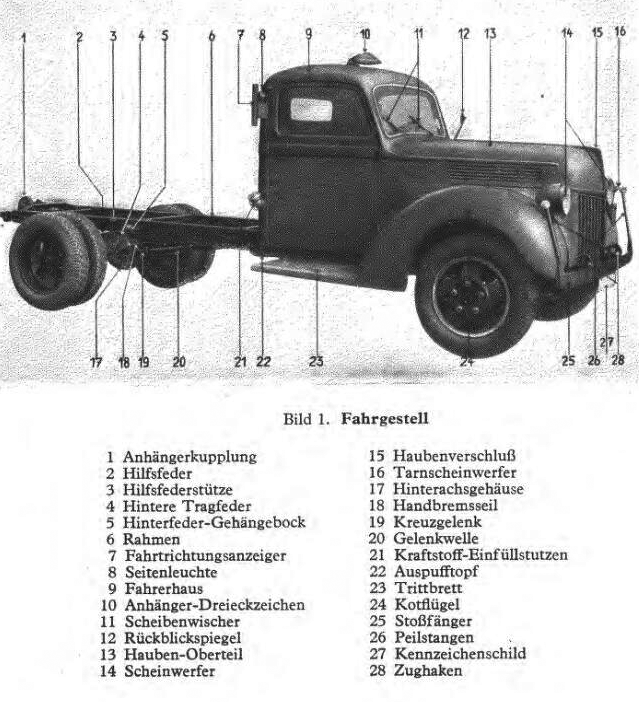
The Ford V 3000 was a conventional truck with a ladder type chassis, separated cab and long bonnet, streamlined, two-axle, rear-axle drive, front steering. It was available with various bodies with the standard having the V8 3.9 liters with Solex downdraft twin carburettor FFIK rated for 95 hp (70 kW) at 3,500 rpm. The cooling system worked with two water pumps. This ended was coupled with a 5-speed gearbox with 5 forward speeds and one reverse, connected to the engine via a Ford single-disk clutch, with mechanical damping, and centrifugal weights. Off-road it reeached 10 km/h was reached on the first gear, then on the 4th gear on road, 85 km/h.
Both front and rear were given rigid axles, with longitudinal leaf springs for suspension. The ATE oil-pressure brake acted directly on brake drums on all four wheels. The handbrake acted via a cable only on the rear drums. Tires were 190×20 front and rear. In off-road mode, the V3000 S could climb 20° or 37%. It was not amphibious of coise but could ford still 44 cm water without preparation, and had an average fuel consumption of 27 l/100 km. Its turning circle was 13.95 meters for a ground clearance of 25 cm.
Ready for use, the standard version weighed 2,540 kg, light (no payload not gasoline). With the maximum permissible payload of 3,310 kg, the permissible total weight reached 5,830 kg. The cab was all metal, with the classic Ford shape, the Geerman model having, instead of the US one, a single piece windshield. The standard flatbed had a folding down back plate, rigid side walls, wih a steel frame and wooden panels easy to replace, and framing (five arches) on which a tarpaulin could be strapped to protect the payload. The side walls in military service had bunks to accommodate five seat boards either side, for ten troops facing inwards.
Ford V3000S specifications |
| Dimensions | 6.35 x 2.25 meters |
| Weight | 2.54 t light, 5.83 t gross |
| Crew | 1 driver, 1 co-driver, 12 soldiers |
| Propulsion | V-8 cyl. gas. 3.3–3.9 liters 95 hp (70 kW) |
| Top speed | 85 km/h |
| Payload | 3 t |
| Transmission | Manual gearshift: 5 forward/1 reverse |
| Suspension | 4 × 2 leaf spring fwd/rear |
| Maximum range | 27 liters/100 km (110 l tank), 400 km |
| Production | 25K in WW2 |
Production and Variants

From 1942 onwards, the Ford plant was limited and specialized in building trucks onl for the war effort at Cologne-Niehl. The plant was initially less affected by Allied air raids on Cologne in the Second World War, so production was able continue with little disruption. But this started to change from October 1944 when the factory premises and workers' camp was flattened twice by Allied bombers. Damage to the plant and residential areas of Cologne led to a temporary shutdown of operations until November 16, 1944.
Under Speer, a reorganiztion of truck production led to a relocation of the final production to the right bank of the Rhine, from August 1944, so production was able to resume quickly. Ultimately when US armed forces arrived, the plant was damaged by German artillery fire from the right bank of the Rhine. By November 1944, almost 80 percent of the production had been relocated almost entirely to the Agger Valley as well as Sieg, near Cologne, across five manufactufing sites with a large distribution of sub-assemblies. The production only ended when all these sites were captured by February 28, 1945. However, from May 4, 1945, Ford resumed production, this time under Allied control and some supervision from Ford USA agaon.
Despite the greatest possible standardization Ford Germany still built four different vehicles called the 3000 series from 1941. The bodies and superstructures were continually simplified as raw materials became increasingly scarce, at first with the "neuer art" less parts and simplified wheels arches forward, flatter fenders, the absence of rear fenders, and eventually the wooden, flat "Einheits cab" or "standard driver's cabs" imposed on al truck models to save steel for war production.
- V 3000S: Standard 3-ton truck
- V 3000 S/SS: Half-track (maultier) variant
- V 3000 A: COE (short nose) variant
- B 3000: Civilian Variant
V 3000S
The 3-ton truck designated V 3000 S, was produced as main, standard model, from 1941. The Ford type was G198TS. It featured the 3.9-liter V8 engine rated for 95 hp. Its wheelbase was 4,013 mm. Its main distinctive feature was found on the hood, curved forward like a bird of prey's beak. Ford worked on further optimizing the design, notably thanks to a team led by engineer Richard Bussien, leading to a new, simplfied model introduced from 1943 onward. The version G388TS (50 hp/3.2 l) and G398TS (95 hp/3.9 l), had a new radiator grille going higher, and the body was change was well, it also featured the first war-related modifications to save material, such as smaller headlights, simplified fenders. The additional bonnet ventilation slots in the hood and the metal-saving standard driver's cab were imposed from 1944, with spare parts ordered according to D 666/10.
V 3000 S/SS
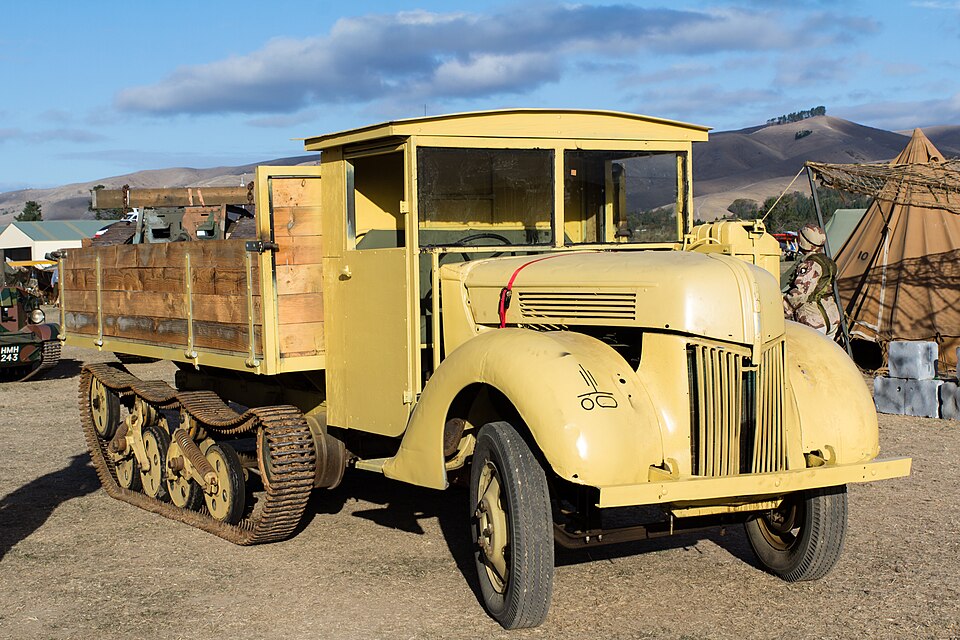
This half-track vehicle, part of the "Maultier" ("Mule") family for the eastern front was developed on the standard V 3000 S, with the first trials made in the winter of 1941/42 in a Waffen-SS unit temporarily firring chassis with captured spare arden-Lloyd tracked chassis coming from the numerous Universal Carrier captured after July 1940 in the Dunkirk pocket and around, foremly in the BEF. This three-roadwheels train was at the rear, replacing the former driving axles, now activated by its drive sprockets. The front axle was still the driving one.
This design was further tested and improved and culminated in the final V 3000 S/SSM "Maultier" (Sd.Kfz. 3b) standardits half track truck, entering series production. It was nor alone, other Maultiers were also produced by rival companies also based on 3-ton trucks, Daimler, Magirus, and Opel. But the majority of these tracked trucks were produced by Ford, with 14,000 "Maultier" manufactured in Cologne and 1,000 at the Ford plant in Asnières, France. With this tracked chassis, the weight penalty was severe however, with a payload reduced to 2 tons, but they proved notably more capable of towing guns. They also ended as self-propelled anti-aircraft guns, when mounted on the cargo area and a few were even lightly armoured to protect the cab. They also followed production simplifications with the 1943 "neuer art" and 1944 "einheits" cab.
V 3000 A
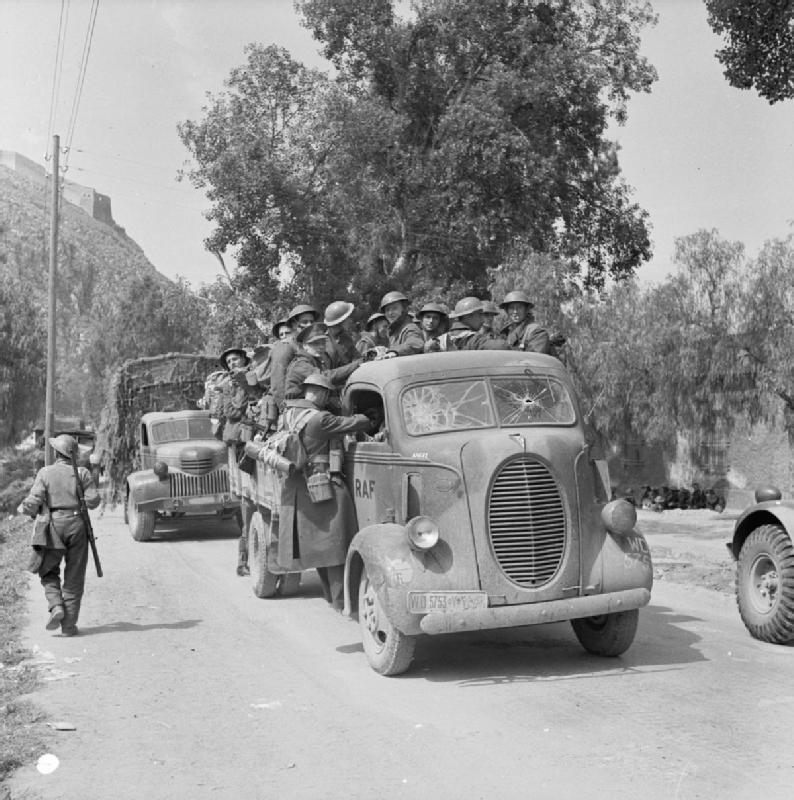
As the war progressed on the Eastern Theater, it became apparent that conventional rear-wheel drive Wehrmacht trucks repeatedly got stuck in off-road operations and had to be extricated with tractors. The Wehmacht pushed for all-wheel drive trucks, and Ford Cologne soon introduced the G198TWA, still powered by a 3.9-liter V8 engine from 1943, produced until 1944. For the first time it was a "short-nose" or COE (Cab Over Engine) cab model, making it more compact, and equivalent to the Ford COE built between 1939 and 1940. These vehicles had an increased suspension travel and featured a transfer case, drive shaft, but more importantly a front-wheel axle drive. Otherwise, these were still in the S (Standard) type. Production was limited compared to the V3000S however. A few hundreds. This was a rare sight indeed.
B 3000
Independent of the production for the Wehrmacht, there was also a continuous demand from the civilian sector. Ford wanted to continue supplying existing customers but, adapted to the wartime situation. In 1941, the B 3000 was created as a civilian version of the V 3000 S, either proposed with a 2-liter 4-cylinder engine rated for 52 hp (38 kW), the Ford G188TD, or an equivalent to the G198TS, with the same 3.9-liter 8-cylinder rated for 95 hp (70 kW) as in the army, but with more creature comforts and without the spare tooling and storage. However as fuel became increasingly rare from 1944, the B 3000 wwas now available with a wood-gasoline version, even a wood gassified, the G188TG.
The Ford V3000S in combat
 A Ford V 3000 S of the Greater Germany Division drives past a rationing point in Russia.
A Ford V 3000 S of the Greater Germany Division drives past a rationing point in Russia.
The 3-ton wartime-production truck helped Ford providing thousands of trukc to newly formed infantry units, replacing existing worn out vehicles, or lost in combat, and broken vehicles as the war was not tender to these trucks, pushed to the limit. However these Ford V3000S were very popular, reliable and strong, well-suited to wartime conditions in Western Europe. On the East this however became extremely difficult due to the poorly developed Russian road network and, and mud or snow in spring and autumn. Especially since these were all rear drive trucks far less capable than off-road vehicles.
Foreign Fords in the Wehrmacht:
In the Commonwealth, Canada, Australia, and Great Britain produced their own foreign Ford variants such as the WOC1 Light Truck and experimental versions with three-axle 6×4 and 6×6 models featuring all-wheel drive, notably from Marmon-Herrington in South Africa and Austrlia. They all had a split windshield, different headlights, some integrated into the fenders. Many German Ford trucks were also captired from the retreating Germans, notably in North Africa with the Tuniian campaign but also in Sicily and Italy. Interchangeability with the allies trucks made them very desirable when captured. In 1944 there was indeed in europe a pool of suitable spare parts from the US to keep them running, so they were still around in 1950.
Postwar period/Successor models:
Despite war-related restrictions, the German Ford factories managed to restart production at Cologne as early as May 8, 1945 under allied supervision to rebuild the country. In 1948, the Ford Rhein (with a V8 engine) appeared, named the G618TS alongside the the Ford Ruhr (4-cylinder engine) named the G388TD model, replaing gradually worn out the V 3000S. Production in the USA, Canada, and Australia was discontinued in Germany whole the smaller Ford Six and Eight series continued until 1947, replaced by the Ford F-Series.
Succession: Ford Ruhr
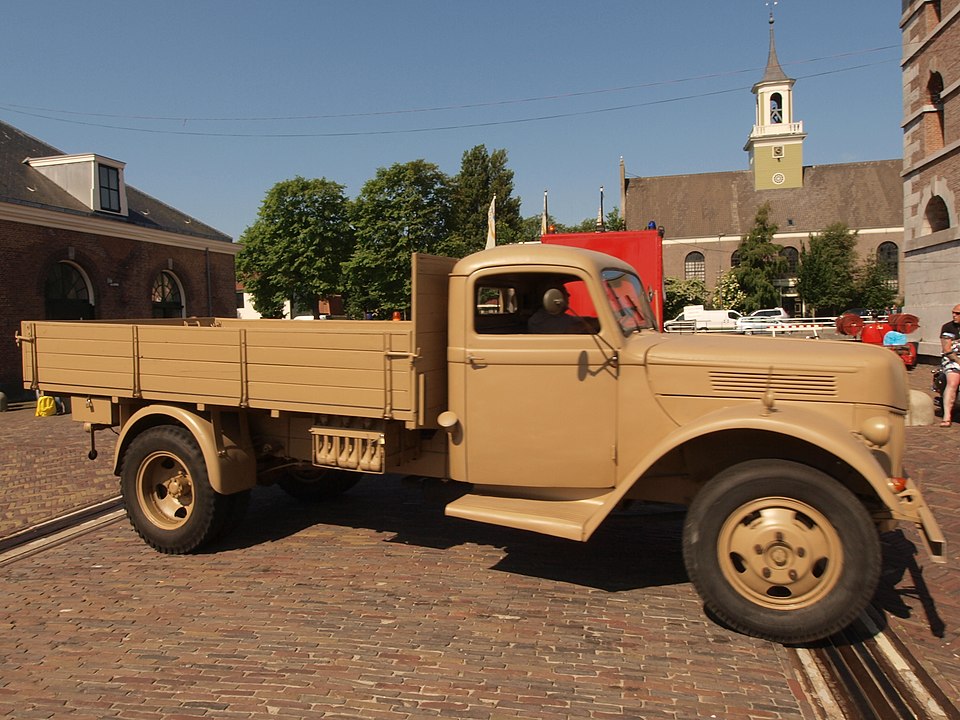 Ford Ruhr built in the Netherlands under licence, 1948.
Ford Ruhr built in the Netherlands under licence, 1948.
The Ford Ruhr (type G388T) from Ford Germany was manufactured with the larger Ford Rhein between 1948 and 1951, the first as a direct successor of the V3000S/B3000. It had an in-line 4-cylinder gasoline rated for 3,285 liters, which developed 52 hp (38 kW), rear wheel drive via a 4/5 speed gearbox. Delivered from the factory with an all-steel driver's cab, gray, plus naked flatbed. The wheelbase was 4013 mm, payload the same. From 1952, they came in 3404 mm wheelbase with a 1,5 or 2t payload as "express trucks" on the brochure. The Ruhr was only available with a gasoline engine, but compatible with a wood gasifier due to fuel shortages post-war. It consumed 17 L/100 km and lost places on the market compared to diesel engines. Its successor, the Ford FK, went with a diesel range.